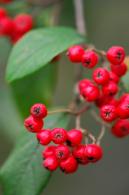Get Additional 5% Off 1st Order
Cotoneaster Lacteus or Late Cotoneaster
1. Add items to basket
2. Go to the basket
3. Enter your postcode in Delivery Price Check
Pot size: 3 Litres
Plant ID: 9618 64
click to view this plant size >Pot size: 10 Litres
Hedge Guide: 3 Plants/Mtr
Plant ID: 9619 64
click to view this plant size >Plant shape: Bush
Pot size: 18 Litres
Hedge Guide: 2 Plants/Mtr
Plant ID: 9620 64
click to view this plant size >
Cotoneaster Lacteus, Late Cotoneaster or Milkflower Cotoneaster
A large evergreen variety of Cotoneaster shrub, Cotoneaster Lacteus offers year-round interest. Its attractive foliage is dark green with a yellowish-white furry underside. The leaves are oval and up to 6 centimetres in size. Early in the summer, this highly decorative shrub bursts with masses of milky-white flowers (hence its common name Milkflower Cotoneaster) which are followed by a profusion of tiny red berries. In addition to being ornamental, these red berries are also very appetizing to birds. The flowers that precede them will invite pollinators into your green oasis (they are much loved by bees in particular), making Late Cotoneaster an excellent choice for wildlife gardens.
Cotoneaster Lacteus is also the recipient of the prestigious RHS Award of Garden Merit (AGM), a sure sign it will perform well in most gardens.
Height and Spread of Cotoneaster Lacteus
Fast-growing but not invasive, Milkflower Cotoneaster is a larger variety of classic Cotoneaster, so you can expect it to reach a maximum height and spread of 2.5 to 4 metres in a period of 10 to 20 years.
How Hardy is Cotoneaster Lacteus
One of the reasons why Late Cotoneaster is so loved by gardeners is that it is undemanding and surprisingly resilient: this evergreen shrub is fully hardy all across the United Kingdom and will fare well even if the winter temperatures drop down to -20 degrees Celsius. The variety will perform well in a windy spot.
How To Use Cotoneaster Lacteus
With a widely arching habit and decorative appearance, Late Cotoneaster works well both when planted on its own and grown in group plantings. The evergreen foliage offers interest and privacy throughout the year, and the summer flowers and wildlife-friendly berries only add to this shrub’s appeal. Milkflower Cotoneaster responds well to pruning, so it makes a good choice for a beautiful hedge or property border.
How To Care For Cotoneaster Lacteus
Cotoneaster Lacteus is not a fussy cultivar and does not require a lot of care to thrive. This evergreen hedging shrub will feel at home both in full sun or partial shade and will do well in almost any soil as long as it is well-drained and on the dryer side of the soil moisture spectrum.














